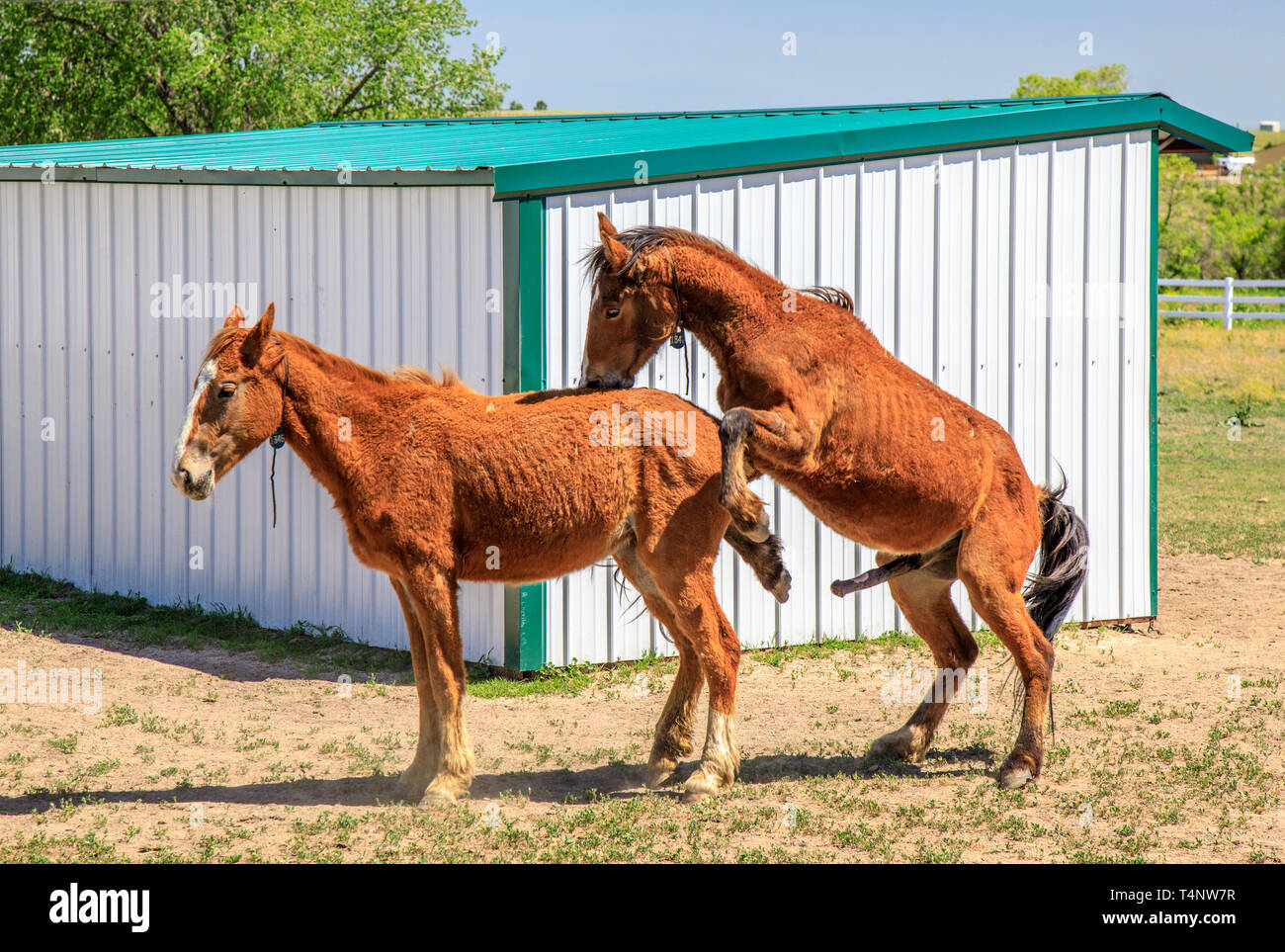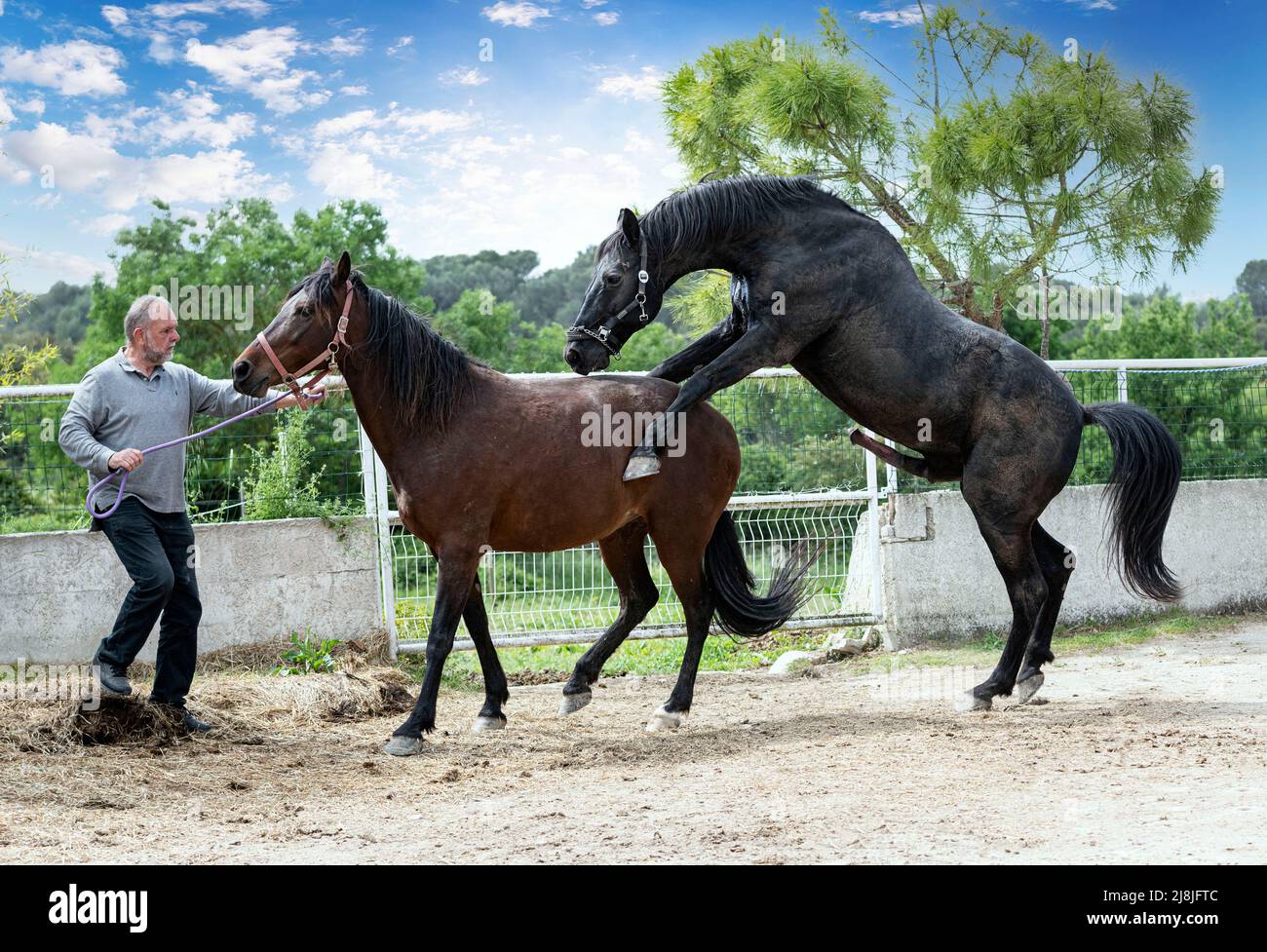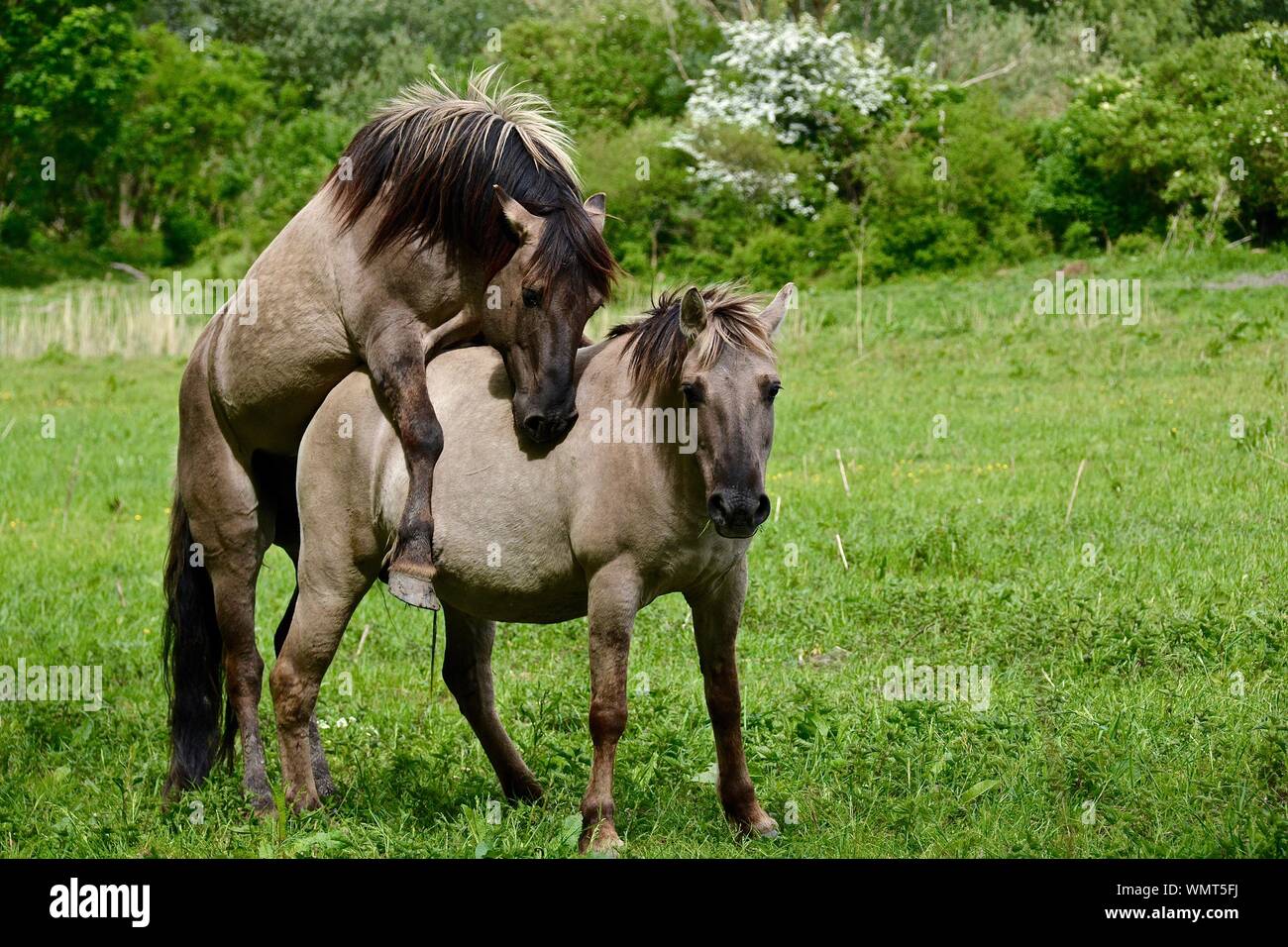Navigating Horse Mating Season: A Comprehensive Owner's Guide
Table of Contents
- Understanding Equine Reproduction: The Basics
- The Influence of Light and Season: Why Spring?
- Identifying Estrus in Mares: Signs of Readiness
- Stallion Behavior During Mating Season
- Preparing for Breeding: Health and Nutrition
- Breeding Methods: Natural vs. Artificial
- Managing Post-Breeding Care and Early Pregnancy
- Challenges and Ethical Considerations in Breeding
- Conclusion
Understanding Equine Reproduction: The Basics
Horses are fascinating creatures, and their reproductive biology is a testament to their evolutionary success. As a species, *Equus caballus* has adapted to thrive in diverse environments, and their reproductive cycles are finely tuned to maximize the chances of successful offspring survival. Mares are seasonally polyestrous, meaning they experience multiple estrous cycles only during certain times of the year, primarily when daylight hours are long. This adaptation ensures that foals are born in the spring or early summer when weather conditions are milder and forage is abundant, providing the best possible start in life. The average gestation period for a mare is approximately 340 days, or about 11 months, reinforcing the importance of timing the breeding correctly within the horse mating season. Understanding this fundamental biological rhythm is the first step for any owner considering breeding. The entire process, from courtship to foaling, is a complex interplay of hormones, behavior, and environmental factors, all designed to perpetuate the species.The Influence of Light and Season: Why Spring?
The primary driver behind the horse mating season is photoperiod, or the length of daylight. As the days lengthen in late winter and early spring, the mare's brain receives signals that stimulate the release of specific hormones, particularly GnRH (Gonadotropin-Releasing Hormone), which in turn triggers the reproductive cycle. This hormonal cascade leads to follicular development on the ovaries and eventually ovulation. This natural timing ensures that mares conceive in the spring, leading to foals being born the following spring, when environmental conditions are most favorable for their survival and growth. For horse owners, this means that the natural horse mating season typically runs from April to September in the Northern Hemisphere, and October to March in the Southern Hemisphere. While artificial lighting programs can manipulate this cycle to encourage earlier breeding, the natural rhythm remains a powerful force. This biological imperative highlights why understanding the seasonal influence is crucial for anyone involved in equine breeding.Identifying Estrus in Mares: Signs of Readiness
Recognizing when a mare is in estrus, or "heat," is critical for successful breeding during the horse mating season. Mares typically cycle every 19-22 days, with estrus lasting 5-7 days. During this period, hormonal changes make them receptive to a stallion. Key signs of estrus include: * **Winking:** Rhythmic eversion of the clitoris, often accompanied by urination. * **Squatting and Urinating:** Mares will often assume a squatting posture and urinate frequently, sometimes in small amounts. * **Tail Flagging:** Lifting and moving the tail to the side. * **Increased Affection/Seeking Attention:** Mares may become more friendly and seek interaction with other horses or handlers. * **Vocalization:** Some mares may whinny or nicker more frequently. * **Acceptance of Stallion:** The most definitive sign is when a mare allows a stallion to approach and mount her, often displaying a relaxed demeanor. Observing these behaviors carefully is essential. For those with pastured horses that aren't fed something else to put the recommended 2 tablespoons into, a salt lick is often used, and daily observation during feeding or turnout can help identify these subtle but important changes. Understanding these signs helps owners time breeding attempts effectively and avoid unnecessary stress on both mare and stallion.Stallion Behavior During Mating Season
Stallions, too, undergo significant behavioral and physiological changes during the horse mating season. While they are capable of breeding year-round, their libido and sperm production often peak during the natural breeding season, mirroring the mare's cycles. A stallion's behavior can become more intense and focused during this time. Signs of a stallion's readiness and interest include: * **Vocalization:** Frequent whinnying or neighing, especially when mares are nearby. * **Increased Alertness:** Heightened awareness of their surroundings, particularly the presence of mares. * **Sniffing and Flehmen Response:** Stallions will often sniff a mare's urine or hindquarters and then display the flehmen response (curling the upper lip) to analyze pheromones. * **Pawing and Striking:** Displaying more energetic and sometimes aggressive behaviors, especially if confined or frustrated. * **Mounting Attempts:** Attempting to mount mares, even if they are not in estrus, as a display of dominance or sexual interest. Managing a stallion during the horse mating season requires careful handling, secure housing, and an understanding of their natural instincts. Their strong constitution and powerful build, characteristic of the *Equus caballus* species, mean that their behavior can be challenging if not managed appropriately. For instance, a 13-year-old OTTB (Off-Track Thoroughbred) warhorse, known for its strength and athleticism, might display particularly robust breeding behaviors, necessitating experienced handling.Preparing for Breeding: Health and Nutrition
Successful breeding during the horse mating season hinges significantly on the overall health and nutritional status of both the mare and the stallion. This is a critical aspect of E-E-A-T and YMYL principles in horse care, as it directly impacts the well-being of the animals and the viability of future offspring.Mare Health and Readiness
A mare intended for breeding must be in optimal physical condition. This includes: * **Body Condition Score:** Mares should not be overweight or underweight. A moderate body condition score (around 5-6 on a 9-point scale) is ideal for fertility and carrying a healthy pregnancy. * **Veterinary Examination:** A thorough veterinary check-up is essential, including reproductive soundness exams, uterine biopsies, and cultures to rule out infections. Issues like lameness, even if a horse "worked out of it" initially but then became "obviously lame at the trot both" after re-shoeing, must be fully resolved before breeding. A lame mare will struggle to carry a pregnancy comfortably or safely. * **Vaccinations and Deworming:** Ensure all vaccinations are up-to-date, and a regular deworming schedule is followed to minimize parasitic load. * **Nutrition:** A balanced diet rich in essential vitamins, minerals, and proteins is crucial. This includes ensuring adequate intake of sodium chloride salt for horses, either through a salt lick for pastured horses or by adding the recommended 2 tablespoons to their feed if they are not on pasture. Proper nutrition supports healthy follicular development and successful pregnancy.Stallion Soundness and Fertility
Stallions also require meticulous preparation for the horse mating season: * **Veterinary Examination:** A breeding soundness examination by a veterinarian is paramount. This includes assessing testicular size and consistency, evaluating semen quality (motility, morphology, concentration), and checking for any physical abnormalities or infections. * **Physical Condition:** Stallions should be fit and healthy, but not excessively fat. Good muscle tone and stamina are important for successful breeding. * **Nutrition:** Like mares, stallions need a well-balanced diet to support sperm production and libido. Specific supplements may be recommended based on individual needs, but a solid foundation of quality forage and feed is key. * **Hoof Care and Lameness:** A stallion must be sound. Any issues, such as those described for the OTTB warhorse, must be addressed. Lameness can impair a stallion's ability to mount and breed effectively and comfortably.Breeding Methods: Natural vs. Artificial
During the horse mating season, breeders have two primary methods for conception: natural cover and artificial insemination (AI). Each has its advantages and disadvantages. * **Natural Cover:** This involves allowing the mare and stallion to breed naturally. It's often preferred for its simplicity and for certain breed registries that require it. However, it carries higher risks of injury to both animals, potential for disease transmission, and requires careful management of the mare's estrus cycle to ensure a successful match. The physical interaction, including the stallion's powerful movements and the mare's potential resistance, necessitates a safe and controlled environment. * **Artificial Insemination (AI):** AI involves collecting semen from the stallion and then artificially introducing it into the mare's uterus. AI offers numerous benefits, including: * **Reduced Risk of Injury:** Eliminates the physical dangers of natural cover. * **Disease Control:** Allows for screening of semen for venereal diseases. * **Geographic Flexibility:** Semen can be shipped across distances, allowing mares to be bred to stallions worldwide. * **Genetic Preservation:** Frozen semen can be stored for long periods. * **Increased Safety:** Particularly beneficial for managing powerful stallions or sensitive mares. However, AI requires specialized equipment, trained personnel, and precise timing, often involving veterinary monitoring of the mare's follicular development. The choice of method depends on various factors, including breed requirements, available facilities, and the health and temperament of the individual horses.Managing Post-Breeding Care and Early Pregnancy
The period immediately following breeding, and the initial stages of pregnancy, are critical for ensuring a successful outcome during the horse mating season.Post-Breeding Checks
After breeding, whether by natural cover or AI, monitoring the mare is crucial. * **Ultrasound Examinations:** Veterinarians typically perform ultrasound examinations as early as 14-16 days post-breeding to confirm pregnancy and check for twins. Early detection of twins is important as equine twin pregnancies are rarely carried to term successfully and often result in the loss of both foals or severe complications for the mare. * **Monitoring for Infection:** Post-breeding uterine infections can occur. The veterinarian may recommend treatments or flushes to prevent this, especially in mares with a history of fertility issues. * **Continued Observation:** Keep a close eye on the mare for any signs of discomfort, discharge, or return to estrus. If she shows signs of returning to heat, it indicates the breeding was unsuccessful, and another attempt may be necessary.Early Pregnancy Care
Once pregnancy is confirmed, the focus shifts to supporting the mare and the developing fetus. * **Nutrition Adjustments:** While significant dietary changes aren't usually needed in the very early stages, ensure the mare continues to receive a balanced diet. As pregnancy progresses, her nutritional needs will increase. * **Reduced Stress:** Minimize stress for the pregnant mare. Maintain a consistent routine and a calm environment. * **Exercise:** Moderate exercise is generally beneficial throughout early pregnancy, promoting good circulation and muscle tone, but avoid strenuous activities or anything that could risk injury. * **Regular Veterinary Check-ups:** Continue with routine veterinary care, including vaccinations and deworming, tailored for pregnant mares.Challenges and Ethical Considerations in Breeding
Breeding horses, while rewarding, comes with its share of challenges and ethical responsibilities. As a forum community dedicated to horse owners and enthusiasts, discussions about breeding often delve into these complex areas, emphasizing health, behavior, and care.Common Breeding Challenges
Even with careful planning, issues can arise during the horse mating season: * **Infertility:** Mares or stallions may have fertility issues that are not immediately apparent. This can range from hormonal imbalances to physical abnormalities or infections. * **Early Embryonic Loss:** A mare may conceive, but the embryo is lost in the early stages of pregnancy, often before 40 days. * **Difficult Pregnancies/Foaling:** Some mares experience complications during pregnancy or during the foaling process itself, which can be life-threatening for both mare and foal. * **Behavioral Issues:** Some mares may be resistant to breeding, or stallions may exhibit overly aggressive behavior, requiring careful management. * **Genetic Defects:** The risk of passing on undesirable genetic traits or predispositions to certain diseases is always a concern. Anyone dealing with something similar to these challenges understands the emotional and financial investment involved. It highlights the importance of thorough veterinary checks and informed decision-making.Ethical Breeding Practices
Beyond the practical aspects, ethical considerations are paramount in horse breeding. * **Purposeful Breeding:** Breeding should always be purposeful, aiming to improve the breed, produce healthy, sound individuals, or fulfill a specific, well-thought-out goal. Breeding simply "to have a foal" without a clear plan or market for the offspring is generally discouraged. * **Welfare of the Animals:** The welfare of the mare, stallion, and future foal must be the top priority. This includes ensuring adequate nutrition, proper housing, and excellent veterinary care throughout the breeding process and beyond. Concerns about issues like hemlock shavings being poisonous to use as bedding (if, for instance, a new load of hemlock and pine shavings arrived and an owner was worried) underscore the constant vigilance required for a safe environment. * **Genetic Responsibility:** Breeders have a responsibility to understand the genetic background of their horses and avoid perpetuating genetic diseases or conformational faults. * **Responsible Placement:** Ensuring that any foals produced will have good homes and a purpose is a critical ethical consideration. The horse world is mighty diverse, with over 300 horse breeds, and each foal deserves a future.Conclusion
The horse mating season is a fascinating and vital period in the life cycle of *Equus caballus*. From understanding the subtle signs of estrus in mares to managing the robust behavior of stallions, and from meticulous health preparations to navigating ethical considerations, responsible breeding demands dedication, knowledge, and a commitment to the welfare of these magnificent animals. We've explored the biological drivers, practical management techniques, and crucial health considerations that underpin successful breeding. As a horse owner or enthusiast, your continued learning about horse history and biology, how to care for them, and the basics of riding is a journey. This guide aims to provide foundational knowledge for all things horses, particularly concerning their reproductive cycles. We encourage you to join the discussion about breeding, grooming, health, behavior, and care within our community. Have you experienced unique challenges during the horse mating season? What insights would you share with fellow enthusiasts? Leave a comment below and share your experiences. Your contributions enrich our collective understanding and help foster a community dedicated to the well-being of all horses.
Horses Mating

Two horses mating in a morning of spring Stock Photo - Alamy

Horses Mating Gif